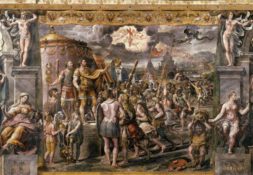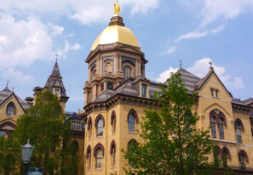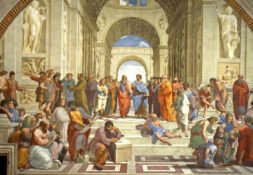As I recall my Notre Dame experience pre-graduation, I am especially grateful for the depth and richness of sacred liturgy available here. Coming from a Catholic church in Minnesota known for its music’s similarity to the local christian pop radio, I had precious little exposure to the Catholic musical and liturgical traditions. I found my only opportunity to explore traditional liturgical music in high school choir. When I began at Notre Dame, I was overwhelmed by all the options for Mass. Each dorm had its own liturgical practices, fostered within each unique dorm community. When I grew bold enough to venture to Masses outside of my residential circles, I discovered basilica Mass and the phenomenal liturgical choirs that accompany worship on the weekends. This year, I have been especially appreciative of a relatively new celebration of the Eucharist that takes place only every other week, a Melkite Catholic Divine Liturgy in Malloy Hall’s chapel.
For those who are unfamiliar with this relatively small sect, the Melkite Greek Catholic Church is one of twenty-three Catholic churches in communion with the pope whose episcopal authority does not originate in Rome. The Melkites of South Bend, for example, have a different bishop, Nicholas. The Melkite Church, similar to the Maronite Church, originated in the Middle East, specifically in Antioch. But while the Maronite Christians utilize a liturgy that developed in the Syriac tradition, the liturgy of the Melkite Church is that of Greek Byzantium. A visitor to the Melkite Divine Liturgy in Malloy will hear hymns in English, Greek, and Arabic. The Melkite Church is not the only congregation to originate in Antioch—so did the Antiochian Orthodox Church, which uses the same Byzantine liturgy but is not in communion with Rome. The Melkites themselves have only been in communion with Rome since 1729. They have made up for lost time since by playing key roles in the two most recent ecumenical councils, Vatican I and Vatican II. During Vatican II, Melkite Patriarch Maximos IV Sayegh advocated for the use of the vernacular in the liturgy, which had been customary for many years in the East.
Although the city of South Bend has long had a Melkite community, Notre Dame never had an Eastern liturgy celebrated on campus until the arrival of the Reverend Professor Khaled Anatolios in 2015. Father Khaled moved to Notre Dame to teach theology and brought the liturgy of the Melkite Church with him. He originally celebrated the Divine Liturgy once a month but the popularity of the liturgy has enabled more frequent Eucharistic and prayer services.
My housemates and I love the Melkite liturgy. Two of us regularly serve in the Mass. My roommate, Stephen Santos, told me that it has become a significant part of his spiritual life at Notre Dame. “The liturgy is incredibly moving, and I find that by participating in the Melkite liturgy, I am better able to participate in my own Latin liturgical tradition.” Stephen, who attended an Episcopal high school, has noticed connections between Melkite and Anglican liturgies. My liturgical senses are not so keen as Stephen’s. Instead, I am struck by the music of the Byzantine liturgy, which is completely unlike anything in a Roman Catholic Church. The hymns occupy different tonal modes than are typically found in Western music. They are striking, haunting, and incredibly difficult to sing at first. They communicate a different spiritual sensibility from music in Roman Catholic churches and require more involved singing from the congregation.
Recently, the Melkite Divine Liturgy had an unexpected effect on my relationships with extended family. When I went to Houston this break on the Glee Club’s spring tour, I stayed at my aunt and uncle’s house. I was a little apprehensive about visiting because I had not seen any of them for over seven years, plenty of time for us to grow apart. Furthermore, my aunt’s family is Greek Orthodox, which has always caused an unintentional spiritual distance between us. We had attended an Orthodox Liturgy together the last time they visited Minnesota, but my siblings and I were confused and discomfited by the foreign liturgy. But last week, their Orthodoxy became a point upon which we could bond, because the Greek Orthodox and Melkite Catholic Churches use the same form, the Liturgy of Saint John Chrysostom.
My newfound familiarity with their form of worship became a ecumenical bonding point, a place where we prayerfully coexisted within our respective faith traditions. The ecumenical actions of bishops past had a direct effect on my family’s life. And if I get to attend a liturgy with my cousins again, I will be able to pray along with the liturgy. There are, to be sure, notable differences between the Melkite and Greek Orthodox celebrations. But the core liturgy remains the same. Thanks to Notre Dame’s rich religious environment, my relationship with my relatives has been deepened.
Michael Moss is a senior majoring in philosophy and political science. He is a founding partner at NewMan, a South Bend-based think tank working to reconcile Thomistic philosophy and contemporary aircraft engine design.





Leave a Reply